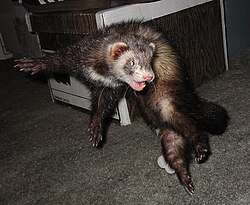
The weasel war dance or mustelid war dance is a colloquial term for the behavior of excited ferrets and other members of the weasel subfamily. Naturalists speculate that weasels in the wild use the dance to confuse or disorient prey. [1]

The weasel war dance or mustelid war dance is a colloquial term for the behavior of excited ferrets and other members of the weasel subfamily. Naturalists speculate that weasels in the wild use the dance to confuse or disorient prey. [1]
This section possibly contains original research .(October 2018) |
In domestic ferrets the war dance usually follows play or the successful capture of a toy or a stolen object. The war dance is commonly held to mean that the ferret is thoroughly enjoying itself.
The behavior consists of a frenzied series of erratic leaps, often accompanied by an arched back and a frizzed-out tail. [2] Ferrets are notoriously clumsy as they dance and will often collide with or fall over objects and furniture.
The war dance usually includes a clucking vocalization, known among domestic ferret owners as "dooking". [3] It normally indicates happiness. Although the war dance may make a ferret appear frightened or angry, they are often just excited and are generally harmless to humans.

The stoat (also known as the ermine or the short-tailed weasel) reputedly mesmerises prey such as rabbits by a "dance" (sometimes called the weasel war dance), though this behaviour could be linked to Skrjabingylus infections. [4] In fact, all weasels, e.g., the least weasel, the European polecat, the steppe polecat, the black-footed ferret, etc., dance when they have caught or killed their prey in the wild.